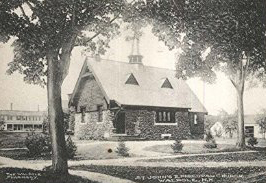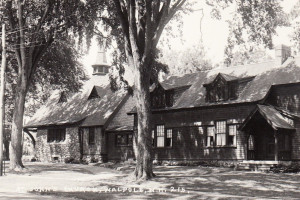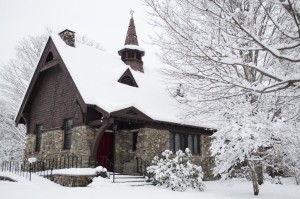The following is excerpted and paraphrased from a manuscript researched and written by our parishioner Charles Howland Montgomery, M.D.
The story of St. John’s Episcopal Church in Walpole really begins with the history of the town, but for the sake of time and space this version of the history of the church will skip ahead and begin with the founding of the “Walpole Episcopalian Society” in 1816. Shortly after, St. Peter’s Church in Drewsville was formed, with worship taking place at private homes. “For several years there was no clergyman. [St. Peter’s] first Rector was the Rev. George Richardson who was also the Rector at Charlestown. He was promptly replaced in both parishes by the Rev. Edward Ballard who stayed until 1831. There were only two communicants. Ballard attempted to reclaim glebe lands as a source of money. The parish struggled, stuttered, and almost came to a halt. In an effort to gain stability it was decided to build a church building and the land upon which it was built was donated by [Thomas Collins] Drew, presumably of the family for whom the village became named” (Montgomery 23).
In 1862, the “Rev. James H. Tyng, Rector of St. Peter’s Church conducted the first Episcopal service in the town Hall in Walpole Villages. Services were held there every Sunday until Fall, when the Methodist Chapel was hired for that purpose” (Montgomery 27, citing Frizzel). On September 27, 1862, the society named “Rector, Wardens and Vestry of St. John’s Church, Walpole, N.H.” was established. It was admitted to the Convention on May 27, 1863 (Montgomery 27). Services were held at the former Methodist Chapel/Catholic Church until 1869. The relationship between St. Peter’s and St. John’s had been discontinued. “The parish was without a clergyman for about ten years, and services were infrequent. During 1877 and 1878 some services were held in the Good Templar’s Hall in the Old Academy Building – [and, possibly,] at times in the large brick Gilson house just west of Route 12 on the Old Keene Road” (Montgomery 27, citing Frizzel).

“During the Summer of 1900, a canvass of the town of Walpole was made by the Rev. Messrs. Parker, Lay, and Dow of the Diocese of New Hampshire. As a direct result of this work St. John’s parish was reorganized in May of 1901, and the Rev. Charles S. Hale conducted services for some months,” in the parlor of the Elmwood Hotel and also in the F.A. Spaulding store (Montgomery 28). “On August 1, 1902, Hudson E. Bridge presented the parish with land on which to erect a church building as a memorial to his daughter Katherine [who lived only from 1897 until 7 May 1900. Her photograph now hangs in the church on the western end of the southern wall.] [The church building] was designed by Mauran, Russel and Garden/Crowell of St. Louis, Missouri” (Montgomery 28).
“On August 21, 1902, the ground was broken; and nearly a year later on August 16, 1903, the first service was held in the new church building…Following the morning service, the corner stone was laid. Three weeks later, on Saturday, September 5, 1903, the building was consecrated as St. John’s Church by the Rt. Rev. William W. Niles, D.D., bishop of the Diocese of New Hampshire” (Montgomery 29).
“A year later, during the rectorship of the Rev. Robert Merriman, work began on a combined parish house and gymnasium. This building, attached to the church building, was dedicated on September 11, 1905, and work was completed in May of the following year. This was the first gymnasium in Walpole Village and was used for both parish and community activities” (Montgomery 30).

“In 1917, St. John’s Church assumed the role of a summer mission: and, from 1921 through 1931, there were only a few services a year (held in the months of July and August). In 1932, the Rev. Louis Reed assumed the responsibility of St. John’s as one of four mission churches under his direction as rector…Occasionally there were visiting clergy and sometimes a seminarian would take the services during the summer months. In this manner the parish maintained a reasonably active worship life…” (Montgomery 30).
“In the late winter of 1961, steering committees from St. John’s, Walpole, and St. James, Keene, met under the encouragement and direction of the Rt. Rev. Charles F. Hall to discuss the possibilities of yoking the two parishes. After considerable discussion it was agreed that a clergyman should be called to serve the two parishes. He would live in Walpole and divide his time as Curate of both parishes. The Rector of St. James, Keene, would assume the titular rectorship of St. John’s and oversee the work that was to be done there…the Rev. James G. Estes [assumed] the duties of the new curacy” (Montgomery 31).
(Here Dr. Montgomery quotes extensively from a document entitled 1903-2003 St. John’s Episcopal Church, Walpole, New Hampshire: Parish Narrative.)

“For the remainder of the ‘sixties [sic], St. John’s was served by William Hazelett – and then by Henry Schaefer. In 1970-71 St. John’s acquired a curate who would serve for seven years. This was Harold Westover, a native of Missouri who had spent a period of clerical service at a major church in Washington, D.C…A brief interval between clergymen was once again aided by St. James of Keene, as the Revered [sic] William Reed conducted a series of services. By 1977, St. John’s had acquired a new leader and a new prayer book.” Ron Prinn stepped into help with the transition to the new prayer book (from the 1928 version), which was not greeted warmly by some parishioners (Montgomery 33-34). The summer of 1978 marked the 75th Anniversary of St. John’s. Ron Prinn was succeeded by The Reverend David E. Evans in 1982. On 27 June 1987, the church celebrated its 125th Anniversary with the Rt. Rev. Douglas E. Theuner as Rector and the Rev. David E. Evans as Vicar.
The 1990s brought the Rev. Robert Freeman to the church, with the building’s 90th Anniversary taking place in 1993. In 1995 St. John’s left mission status and obtained full parish status (Montgomery 37). The Rev. Freeman retired in the summer of 2002, and the following summer the centennial anniversary of the church building was celebrated. The next few years were difficult ones for both St. John’s and the Episcopal Church in New Hampshire, with the election of Bishop Eugene Robinson causing strife both at home and abroad. The Episcopal Church has a long history of progressive values, but change does not always come painlessly (Montgomery 35).

The Rev. Susan de Puy Kershaw was called to be our rector in 2004. After more than 25 years serving as a Baptist minister, Rev. Kershaw was ordained as an Episcopal priest just a few weeks before she began her service at St. John’s (Montgomery 37). Rev. Kershaw has brought about a new era at St. John’s Church. Her after-school ministries (Art After School and Art + Faith After School) have been incredibly successful, and have brought about a new sense of vitality and purpose for this parish. Rev. Kershaw retired on November 30, 2019, and we have embarked on a search for our next leader. And, that brings us to the present day!
Works Cited:
Montgomery, Charles Howland. The Evolution of St. John’s Episcopal Church Walpole, New Hampshire. September 2012. TS. Collection of Charles Howland Montgomery, Walpole, New Hampshire.
